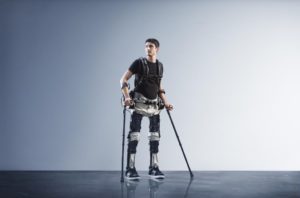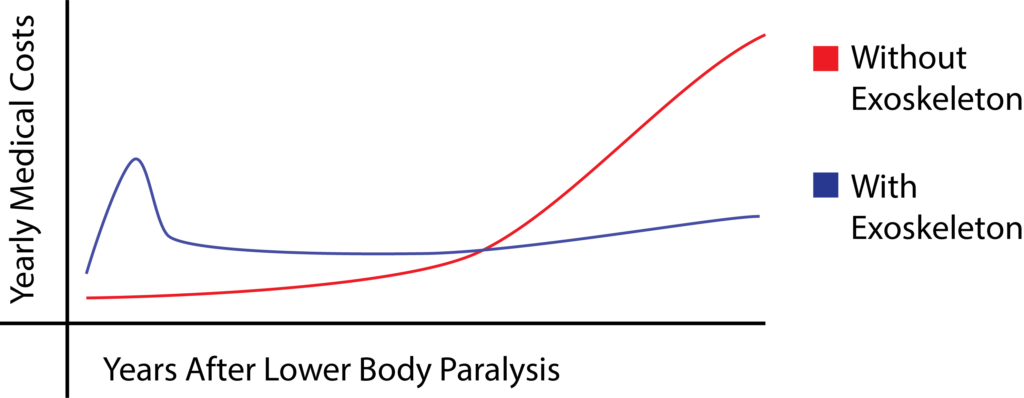Unless something drastically changes in the last two months of 2017, the best article written regarding medical exoskeletons is not going to go to the Exoskeleton Report but to Reuters! Andrei Khalip from Reuters has written a heartfelt account of his journey to SuitX in the San Francisco Bay Area to try out the Phoenix powered gait rehabilitation exoskeleton: Full article at Reuters.com Special Report: Me and my robotic suit
Why is this the best medical exoskeleton article for 2017:
As Andrei Khalip begins his article, we learn that twenty-one years ago he suffered an injury below his 12th dorsal vertebrate (T12 Thoracic Vertebrate, see InnerBody.com) and has been paralyzed in both legs since. Immediately after that introduction, Mr. Khalip deviates from your usual exoskeleton article. Rather than talking about Iron Man or wearable robotics, he tells a story of how his friends constantly bombard him with news of the latest technology and experiments being hyped up to cure paralysis like stem cell research, implants and electro-caps that bypass the injury area.

A second thing that Mr. Khalip does differently is to explain in simple terms to the reader what he wants from a lower body exoskeleton: it is not to move around everywhere without a wheelchair or see people at eye level. No, he wants a practical device that can enable him to stand up and be upright every day for health reasons. Humans are made to stand and walk. Not doing so causes a myriad of what is commonly referred to as “secondary conditions” due to paralysis. Mr. Khalip lists bone density loss, a significant increase in infections, issues with blood circulation, and digestive tract problems. In addition, pressure sores, increased likelihood of diabetes, back pain, and premature death can also be attributed to not being upright.
Third, Mr. Khalip gives the briefest of overviews of the currently available leg braces that he uses at home to stay upright. He describes them as locking in place and uncomfortable. Like most people in his position, he skips using them but realizes the health implications of doing so. In just a few sentences the author has painted a complete picture of what is currently available for paraplegics, why they have to use it, and the difference between promising vs practical aids.
Off to SuitX:
“Phoenix and I did not hit it off right away. In fact, had it just been a test drive and not the intensive two-week program I had signed up for, I probably would have decided that it was not for me.”
Unlike what some may want us to believe, getting into a walking assist exoskeleton for the first time is hard. The fear of falling, nervousness, the difficulty of shifting weight from one foot to the other are all real challenges that must be factored in, not swept under the rug. Fortunately, Mr. Khalip had signed up for a full two-week program. Inspired by SuitX’s primary PhoeniX user, Steve Sanchez, Mr. Khalip began feeling more confident in the exoskeleton by his fourth session. By the end of the program, he not only got faster but could feel benefits of being upright and walking every day.

The justification for walking assistance exoskeletons:
Mr. Khalip has created an easy to read and accessible to the public article that setups the health benefits that medical exoskeletons can bring to paraplegics. This is the justification for powered, lower body exoskeletons for gait assistance and rehabilitation: they are expensive upfront and require maintenance, but they should reduce long-term medical expenses for people with a walking disability.

(Above) exoskeletons have a steep upfront cost and a maintenance cost, however, long-term they should produce an enormous saving in medical costs to the user in addition to an improved quality of life. Undoubtedly powered medical exoskeletons will not see any mass adoption without insurance coverage.
Links:
Special Report: Me and my robotic suit, Andrei Khalip, Reuters, October 27, 2017, https://www.reuters.com/article/us-health-exoskeleton-specialreport/special-report-me-and-my-robotic-suit-idUSKBN1CW1D6
SuitX, Developer of medical and industrial exoskeletons, http://www.suitx.com








It’s a very interesting chart. Do you by any chance have scientific data about medical cost with and without an exoskeleton?
No, but I believe Ekso Bionics and/or ReWalk do have the same chart but with more research behind it. Please attempt to contact either/both sales teams.
Thank you very much, it’s a good idea